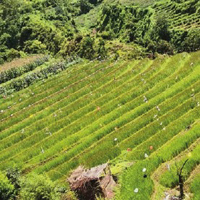Discovering genetic diversity of Changmaogu, a rice landrace, for conservation and rural development

Accepted: 18 July 2021
HTML: 18
All claims expressed in this article are solely those of the authors and do not necessarily represent those of their affiliated organizations, or those of the publisher, the editors and the reviewers. Any product that may be evaluated in this article or claim that may be made by its manufacturer is not guaranteed or endorsed by the publisher.
Changmaogu is a very rare and endangered rice landrace cultivated in a very limited area by Lama people, a branch of Bai ethnic group in Lanping County, Yunnan, China. No study on this precious landrace had been reported. This study was intended to explore the genetic diversity so as to develop strategy for conserving Changmaogu. The Changmaogu samples were compared with other three varieties (Hejing 16, Nipponbare and Hongxiangmi), using 24 pairs of SSR markers. Among all varieties, Changmaogu showed the richest genetic diversity. Cluster analysis also showed that Changmaogu can be distinguished in the genetic distance of 0.68. These data suggested that landrace is of great significance for the selection of rice varieties under the harsh environment and the acquisition of parents in the breeding work. The high altitude, low temperature and complex microbial community may be the important factors of genetic diversity in Changmaogu. The influence of ‘agriculture-processing-marketing’ mode of landraces should be continuously tracked. The strategy for conservation and sustainable development of Changmaogu was proposed in the present paper.
Highlights
- Changmaogu, a very rare and endangered rice landrace cultivated in a very limited area by Lama people, has more abundant genetic diversity than the three compared cultivars-Hejing 16, Nipponbare and Hongxiangmi, which enables it to adapt to changing environmental conditions, ensures local food supply and agricultural economic development, and makes it an effective supplement to the rice gene pool.
- The result of UPGMA clustering analysis based on genetic distance led to the formation of three clusters, which Changmaogu had further genetic distance compared with hybrid rice Hejing 16 and rice parents Nipponbare, further revealing the utilization potential of Changmaogu in crop breeding.
- The genetic diversity of Changmaogu and Hongxiangmi was compared to reveal the important position of Changmaogu in the protection of landrace, and to explore the potential impact of commercial activities on the genetic diversity of landrace.
- According to the case of Changmaogu, this paper puts forward reasonable and effective strategies for the protection, which can be derived and applied to the protection of other landraces.
How to Cite

This work is licensed under a Creative Commons Attribution-NonCommercial 4.0 International License.
PAGEPress has chosen to apply the Creative Commons Attribution NonCommercial 4.0 International License (CC BY-NC 4.0) to all manuscripts to be published.

 https://doi.org/10.4081/ija.2021.1870
https://doi.org/10.4081/ija.2021.1870







